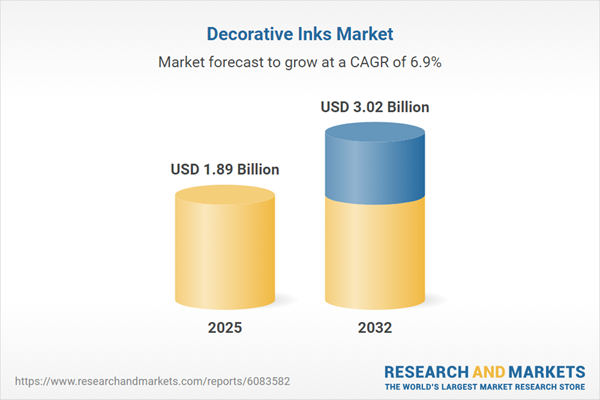Speak directly to the analyst to clarify any post sales queries you may have.
The decorative inks market is evolving rapidly, shaped by significant changes in technology, sustainability pressures, and altered global trade patterns. Senior leaders will find actionable intelligence here to support resilient, future-focused decision-making in this dynamic specialty chemicals sector.
Market Snapshot: Decorative Inks Market Size and Growth
The decorative inks market grew from USD 1.77 billion in 2024 to USD 1.89 billion in 2025 and is forecast to reach USD 3.02 billion by 2032, reflecting a robust CAGR of 6.90%. This sustained expansion is anchored in the market’s diverse applications, ongoing portfolio innovations, and strategic investments from both global and regional players. Decorative inks now underpin a range of critical industries, including advertising/signage, ceramics, textiles, and advanced packaging, as they respond to the dual imperatives of product differentiation and regulatory compliance.
Scope & Segmentation of the Decorative Inks Market
This comprehensive market research provides a structured view of decorative ink opportunities, technologies, and regional dynamics.
- Ink Types: Acid dye, direct dye, reactive dye, sublimation dye, fluorescent pigment, gloss pigment, metallic pigment, pearlescent pigment.
- Sales Channels: In-house sales teams, manufacturer sales force, general distributors, specialist distributors, manufacturer e-commerce, third-party online platforms.
- End User Industries: Indoor signage, outdoor signage, ceramic tiles, glassware, automotive interiors, fashion accessories, apparel printing, home textiles.
- Technology Types: Ethanol-based solvent, ketone-based solvent, LED-curable UV, mercury lamp curing UV, acrylic emulsion water-based, vinyl acetate water-based inks.
- Application Areas: Ceramic decoration, murals, stencil art, packaging labels, promotional items, digital textile printing, screen printing.
- Regional Focus: North America, Latin America, Europe, Middle East, Africa, Asia-Pacific, including key economies such as the United States, China, India, Germany, and Japan.
- Key Companies Covered: Sun Chemical Corporation, Siegwerk Druckfarben, Flint Group, DIC Corporation, Toyo Ink, Sakata INX, INX International, Dainichiseika, Fujifilm Sericol, Hubergroup Deutschland.
Key Takeaways for Senior Stakeholders
- Advances in digital and UV-curable printing technologies are reshaping production and enabling more efficient, customized decorative applications.
- An accelerating industry shift toward water-based and low-VOC formulations addresses tightening global environmental requirements and customer demands for safer, more sustainable products.
- Regional differentiation is pronounced; Asia-Pacific demonstrates innovation and scaling advantages, while North America and Europe prioritize compliance and product premiumization.
- Strategic supplier diversification and nearshoring initiatives are increasingly vital as businesses adapt to shifting tariff and trade policy landscapes.
- Brands and print service providers are pursuing value-added offerings, such as tactile and specialty finishes, to meet rising consumer expectations and create product distinction.
- Successful companies invest in R&D, harness digital integration for process monitoring, and foster partnerships to accelerate go-to-market strategies with resilient supply frameworks.
2025 United States Tariffs: Effects on the Decorative Inks Market
Recent US tariffs on imported decorative ink raw materials and substrates have driven pronounced supply chain adjustments. Industry leaders have reconfigured sourcing strategies, amplified domestic production, and engaged in cost-control collaborations with buyers. The outcome has been an industry-wide push for greater value chain efficiency, closer vendor relationships, and the reevaluation of inventory and pricing models. Manufacturers who act early to localize production and diversify supply partners are better positioned for sustained competitiveness under complex tariff regimes.
Methodology & Data Sources
This research synthesizes quantitative and qualitative data through stakeholder interviews, review of company reports, patent analysis, and triangulated industry publication insights. Market segmentation was validated through a rigorous combination of top-down and bottom-up approaches, ensuring every segment aligns with actual industry structures. Data analysis included trend extrapolation, scenario modeling, and competitive benchmarking across major and emerging market participants.
Why This Report Matters
- Equip business leaders with strategic clarity on technology and sustainability trends driving market transformation.
- Enable informed investment and sourcing decisions by providing actionable segmentation insights and regional intelligence tailored for complex market realities.
- Support proactive risk mitigation, operational resilience, and innovation with forward-looking competitive analysis and supply chain impact assessment.
Conclusion
The decorative inks market is characterized by rapid technological shifts, heightened sustainability requirements, and evolving supply dynamics. Leaders who adapt to these trends by investing in innovation, optimizing supply chains, and focusing on tailored regional strategies will be best equipped for future growth and profitability.
Table of Contents
3. Executive Summary
4. Market Overview
7. Cumulative Impact of Artificial Intelligence 2025
Companies Mentioned
The companies profiled in this Decorative Inks market report include:- Sun Chemical Corporation
- Siegwerk Druckfarben AG & Co. KGaA
- Flint Group
- DIC Corporation
- Toyo Ink Co., Ltd.
- Sakata INX Corporation
- INX International Ink Co.
- Dainichiseika Color & Chemicals Mfg. Co., Ltd.
- Fujifilm Sericol Limited
- Hubergroup Deutschland GmbH
Table Information
| Report Attribute | Details |
|---|---|
| No. of Pages | 183 |
| Published | October 2025 |
| Forecast Period | 2025 - 2032 |
| Estimated Market Value ( USD | $ 1.89 Billion |
| Forecasted Market Value ( USD | $ 3.02 Billion |
| Compound Annual Growth Rate | 6.9% |
| Regions Covered | Global |
| No. of Companies Mentioned | 11 |









